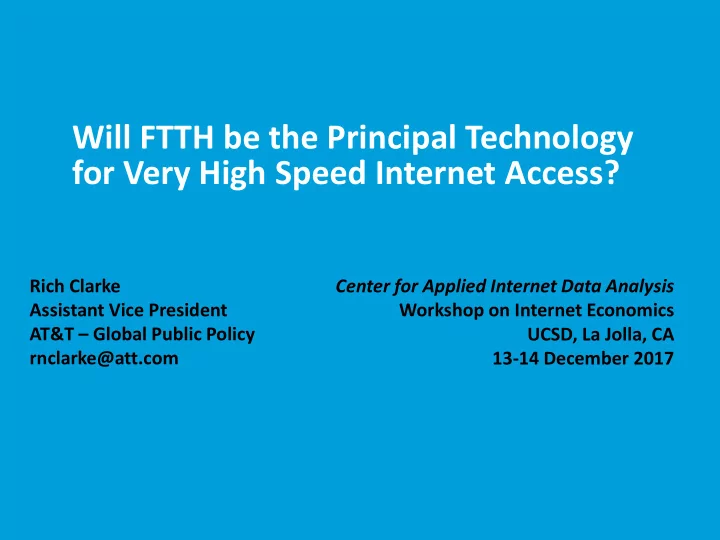

Will FTTH be the Principal Technology for Very High Speed Internet Access? Rich Clarke Center for Applied Internet Data Analysis Assistant Vice President Workshop on Internet Economics AT&T – Global Public Policy UCSD, La Jolla, CA rnclarke@att.com 13-14 December 2017
Has “peak FTTH” passed? Disclaimer The statements and conclusions in this presentation are those of the author alone, and should not be construed as representing any official position of AT&T. 2
Has “peak FTTH” passed? Where we were and where we are Ten years ago, it was a foregone conclusion that most residences were going to be served by FTTH • Ultra-HD video was going to require FTTH speeds • Customers were going to do nearly as much uploading as downloading • Verizon FiOS was the future, while xDSL and DOCSIS were just stopgaps Now, this is in doubt • FiOS maxed out at less than half of Verizon households • Gigapower will reach less than a quarter of AT&T households • DOCSIS 3.x, LTE, LTE-A and 5G are accelerating – and even xDSL is proving resilient (via pair-bonding, vectoring and G.fast) • Video compression continues to improve Have we seen “peak FTTH?” 3
Has “peak FTTH” passed? FTTH costs are challenging The closer equipment is to the customer’s home, the greater its share of total network cost • Costs to pass in urban/suburban areas are $700-$1000 • Costs to connect are ~$800 But take-up generally has been <40% • Implies per sub incremental investment of $2500-$3300, and even at 50-55% take-up these investments remain >$2000/sub; while • DOCSIS, xDSL or LTE incremental investments are only a fraction of this 4
Has “peak FTTH” passed? Which makes FTTH economics challenging Customers don’t assign significant extra value to FTTH • 100Mbps worth ~$5/month more than 25Mbps, but extra cost is much more • Traffic demands remain highly asymmetrical Total fixed broadband take-up remains stuck at 70-75% • Even highest decile of U.S. counties by household income has only 85% take- up, and highest decile of counties by education has only 86% take-up • Unlimited mobile broadband has also hurt fixed take-ups And almost always, FTTH needs to compete against very capable alternatives • DOCSIS/xDSL costs mostly success-based versus FTTH sunk costs-to-pass • Capabilities of mobile wireless rival or exceed those of as-used FTTH • High real options cost of deploying FTTH currently 5
Has “peak FTTH” passed? Conclusions Unless customer preferences change to incorporate some FTTH capability that is not matchable by alternatives; or Unless FTTH costs become more favorable relative to alternatives We may be seeing “peak FTTH,” only time will tell As with other OECD countries, high speed may not equate to FTTH 6
Recommend
More recommend